National Defense Strategy? What National Defense Strategy?
Imagine the summer of 1940 blissfully planning like it was 1938
Were you aware this tasker was working its way through the system?
Congress established the Commission on the National Defense Strategy by statute to examine and make recommendations with respect to the National Defense Strategy.
Well, RAND has the goods,
As part of the Commission's role, it conducted a review of the "assumptions, strategic objectives, priority missions, major investments in defense capabilities, force posture and structure, operational concepts, and strategic and military risks" associated with the 2022 National Defense Strategy (PDF). The Commission called on RAND to provide administrative and analytic support.
Did you catch this yummy little morsel?
The current National Defense Strategy (NDS), written in 2022, does not account for ongoing wars in Europe and the Middle East and the possibility of a larger war in Asia. Continuing with the current strategy, bureaucratic approach, and level of resources will weaken the United States’ relative position against the gathering, and partnering, threats it faces.
Remember this tasty nougat center for later:
…does not account for ongoing wars in Europe and the Middle East and the possibility of a larger war in Asia.
Basically, they’re reminding us that we have a nation’s security running on an obsolete autopilot. Bravo Zulu for putting that marker out early. In a fashion, the report could have ended there. Probably should have ended there, but alas … no.
As Noah Robertson noted in his reporting, this report was not due until the end of the year. However, the commissioners decided to deliver it early so it could be part of the election conversation.
This election cycle has different plans.
While I appreciate the move — one I would have encouraged — I’m not sure either party wants to engage on the topic as there is only so much bandwidth in an election year … and … will you look at what happened in the last month?
However, there is a mission to complete … and they completed it early. There is praise due for that.
Who are the “they”? People are policy, so let’s review the commissioners in Appendix A on page 77. The extended bios are there.
Jane Harman: former Representative (D-CA).
Eric Edelman: retired ambassador and career Foreign Service official.
John Keane: retired General, US Army.
Thomas Mahnken: senior official at CSBA and SAIS.
Mara Rudman: professor and former (D) executive branch staffer.
Mariah Sixkiller: defense consultant and former (D) legislative branch staffer.
Alissa Starzak: attorney and former (D) staffer.
Roger Zakheim: attorney, Director of the Ronal Reagan Presidential Foundation and Institute, and it appears various (R) appointments.
So, if the nation is in a bit of a national security pickle, everyone above had a role in getting us here. For better or worse, that is a simple fact. Keep that in mind as you read the report. It does not mean it is a bad report, but it does help you understand the kitchen the cooking took place in.
Note that not one of the commissioners has a background in economics, leadership in industry, or other “arsenal of democracy” areas. That is - suboptimal and it shows.
I have…concerns in other foundational issues as well.
There is plenty to chew on and it is a meaty document, so I am just going to touch on a few things in the Summary that I hope will encourage you to dive in for yourself for the details. No one wants me to fisk a 100+ page report.
My primary concern came early when the Balrog of Beltway natsec theory appeared;
In its report, the Commission on the National Defense Strategy recommends a sharp break with the way the U.S. Department of Defense (DoD) does business and embraces an “all elements of national power” approach to national security. It recommends spending smarter and spending more across the national security agencies of government.
In the name of all that is holy. There is nothing more worn out in natsec discussions coming from the Imperial City than “all elements of national power.” The “whole of government” mating with the “interagency.” Yes, yes, yes, we know - the four walls of the food trough. This is not an insight, this is rice bowl protection.
Yawn.
That is just a tell that people were invited inside the tent were very concerned that DOD might get more money and the civilian part of the natsec bureaucracy wouldn’t get an equal plus up of funds. Requirements be damned, we have budget-pie ego issues that need to be addressed.
As the kids would say, “basic.”
Buddha forbid that DOD get $1 and at the same time we don’t give $1 to every other kid at the table. It really is one of the most unimaginative instincts of the established natsec nomenklatura.
As we’ll see again, this DC habit of holding defense spending hostage for “less icky” levers of power or petty domestic programs making everything unaffordable. People tasked with “hard decisions” decide the “hard decision” is to decide to say “yes” to every good-idea fairy that threatens to heavily pout if their #1 goal is not your #1 goal.
Here is the top-10 list of my #1 priorities - DC commissions
If your shields don’t go up, your wallet pushed deeper in your pocket, your eye twitch start, your children hidden, and you don’t instinctively reach for your side-arm when you see a Beltway entity mention, “spending smarter and spending more across the national security agencies of the government” then you have not paid attention the last quarter century.
There is some good in this report - but it does not have fresh eyes on the problem and as a result suffers and is conceptually hobbled. There are a lot of people involved here that, well, are the status quo. As a result - if we are looking to break a bureaucratic logjam, I’m not sure of its utility besides answering the mail from Congress.
So, we have a good and a bad all one paragraph apart early on. That’s OK, its just my opinion. Which way shall it all go? Well, let’s see.
Get the report here and first go to Table D-1 on page 92 to see who testified in front of the commission.
At a glance, they seem to have covered both political parties and diversity of opinions and world views. One could call it “swampy” like the commissioners if you want … but it is what it is. There are a few disruptive folks here - good disruptive - but their influence is heavily diluted.
Enough of me falling into a comfortable groove of critique. Time to look at graphs in the Summary. Pictures are good.
I’ll go ahead and say it: we will be lucky to maintain 3% without a Chief Executive who has this as a priority backed up by leadership in the Legislative Branch who are willing to expend political capital to underwrite the effort.
Look around the room.
As this is a political year, I find this modification by me … interesting, especially over the last 50 years. There’s a pattern.
We got here via a bi-partisan effort, and this is about as political as I’ll get on this post. I wanted to put it here only because that is a pattern I’ve seen since college that isn’t really talked about much. If you don’t see it, I’m not sure how I can help you.
Back to the report.
I do so love this passive aggressive, “No one listens anyway, but sure, we’ll go through this exercise again.” This is very good.
There are good, smart people trying hard in that time period … but their influence was, where it counts … not that effective.
Part of the below is, well … there’s a lot of wishcasting here. We’ll take the recommendations bullet by bullet:
The Commission makes the following resource recommendations for DoD and Congress:
• DoD should immediately review all major systems against likely future needs, emphasizing battlefield utility and prioritizing agility, interoperability, and survivability. The Office of the Secretary of Defense and the Joint Staff should be more empowered to cancel programs, determine needs for the future, and invest accordingly. DoD should invest more in cyber, space, and software, which have enabled warfighting for decades but are now central to conflict and have global reach.
The primary lesson of the Russo-Ukrainian War, a three-week war now in its third year, is that the West's iterative layering of assumptions about “the needs of the future,” waiting for magic beans to make war easier, cheaper, and faster, has led to an existential decline in the industrial capability and magazine depth required to actually wage war as it is required. Not as it is desire, but as it is required.
Remember the sub-pull quote above? Here is where it should be fun to bring back.
…does not account for ongoing wars in Europe and the Middle East and the possibility of a larger war in Asia.
Heal thyself my dear commissioners. Heal thyself.
Yes, we should invest in cyber, space, and software - we see that in UKR too - but what drives the modern conflict is something familiar if unsexy; artillery, manpower, logistics, armor, and good old fashioned electronic warfare. The Gaza War is sending similar signals.
• Congress should pass a supplemental appropriation immediately to begin a multiyear investment in the national security innovation and industrial base. Funding should support U.S. allies at war; expand industrial capacity, including infrastructure for shipbuilding and the ability to surge munitions production; increase and accelerate military construction to expand and harden facilities in Asia; secure access to critical minerals; and invest in a digital and industrial workforce.
This is about perfect, but it is trying to be all things to all people. We do not have the luxury of just growing the budgetary pie so everyone gets a the same proportional slice. We are in “The Terrible 20s” and all were warned of this situation 14 years ago.
That should have been the first bullet and been bold enough to be focused, but if this is the message, bold iot, underline it, have it on a banner pulled behind a Cessna 172 circling Capitol Hill all summer … 220, 221, whatever it takes.
• DoD should immediately begin making structural changes and prioritization adjustments to spend national security funds more effectively and more efficiently. DoD should address its recruitment challenges, rewrite regulations to speed defense procurement (and address cultural impediments and risk aversion), and shift the R&D paradigm to adopt technological innovation from outside the department for warfighting purposes. The U.S. government should review national security authorities for agencies other than DoD and look for ways to enable and facilitate information-sharing, coproduction, and export controls to better work with allies.
OK, perhaps this is just me projecting on to others … but is that just a rephrasing of the cornerstones of Plan Salamander; replace Goldwater-Nichols, root-and-branch acquisitions reform, and COCOM reform? Let’s pretend it is and applaud it.
• Congress should revoke or override the caps in the 2023 Fiscal Responsibility Act that serve as the basis for the FY 2025 budget request.
– For FY 2025, real growth in defense and nondefense national security spending is needed and, at a bare minimum, should fall within the range recommended by the 2018 NDS Commission. While the reforms recommended above are being made and investments in capacity from the supplemental appropriation are underway, increased spending should be allocated to emphasize near-term readiness demands to restore and reinforce deterrence.
This is where an economist might come in handy, because this is the first of three breadcrumbs that lead to a non-starter.
– Given the severity of the threats, the FY 2027 and later budgets for all elements of national power will require spending that puts defense and other components of national security on a glide path to support efforts commensurate with the U.S. national effort seen during the Cold War.
Yes, I can agree with that.
– Larger amounts of defense spending should be accompanied by sufficient resources to build capacity at the departments of State, Commerce, and Treasury; intelligence, trade, and investment agencies; the U.S. Agency for International Development; and the Department of Homeland Security and focus these organizations on national security missions. The United States should continue to provide support to its allies, which it relies on to fight with (or for) it.
…and here is when things become childish and irresponsible. If everything is critical, nothing it critical. No one believes that the State Department and Homeland Security are not bloated and inefficient - not to mention ineffective - departments. Throwing more money at … whatever their bloated legions of bureaucrats who never leave DC do … is simply, well, insulting.
– The ballooning U.S. deficit also poses national security risks. Therefore, increased security spending should be accompanied by additional taxes and reforms to entitlement spending.
… and here is where the breadcrumbs lead. The U.S. deficit is our #1 national threat and is already turning the curve to unrecoverable parts of the curve because people will not make hard decisions.
Everyone does not - indeed cannot - just get more money. Who in politics can find a way to reform entitlement spending and increase taxes inside the next four POM cycles? That will have to be done before any large increases in defense. Who will say, “no” to those who demand $1 in welfare state spending for each increase of a $1 towards natsec spending.
If your answer is “no one,” then we need to have a discussion of a Plan-B. Where is that?
The lack of preparedness to meet the challenges to U.S. national security is the result of many years of failure to recognize the changing threats and to transform the U.S. national security structure and has been exacerbated by the 2011 Budget Control Act, repeated continuing resolutions, and inflexible government systems. The United States is still failing to act with the urgency required, across administrations and without regard to governing party.
This report proposes a new approach to spur the speed and scale of change. Implementing these recommendations to boost all elements of national power will require sustained presidential leadership and a fundamental change in mindset at the Pentagon, at the National Security Council and across executive branch departments and agencies, in Congress, and among the American public writ large.
This is not a “new approach.” This is an exercise in wishcasting.
The money isn’t coming. The reform is not coming - at least with the people we have now. It would take a lucky turn of the wheel in November 2024 to have the stars align…but hope is not helpful.
Where is the report that says, “If we cannot do this, then these are the other two options…” or three, or one?
There is what we need, and this reports does a good job outlining what those are, but there is also what we will get.
Santa will most likely not give us a pony this Christmas, but we might get some new t-shirts and a bike. So, what will we do that that?








CDR, spot on (as usual). What do you with a bankrupt process? You go broke. Patterns of human behavior historically (there's that word) repeat. "Gentleman, we've run out of money, we're going to have to start thinking." (British head of admiralty a long time ago, IIRC...or not). Problem is, government, and DoD "thinks" badly, if at all. As our national debt explodes, discretionary spending (DoD is the largest component still, I think) is going to shrink, not grow. The acquisition process (JCIDS, anyone?) and Military Industrial Complex (TM) have gotten slower and more expensive (slow multiplies cost, so how is that helpful, JCIDS, asking for a friend). So, we've run out, or our running out of money, and apparently can't think. We can't do analysis, so we can't determine what our future needs will be with any confidence, so we get think tank produced thought pieces like this that highlight (what you aptly pointed out), the utter inability to make a choice...in anything. Everything is critical, DoD, State, HHS, et al. If ever someone is going to take a serious run at disrupting the current world order, I'd say we've entered a very dangerous window of time.
So history rhymes. We are repeating Britain in the 1920s and 1930s, only now with Powerpoint.